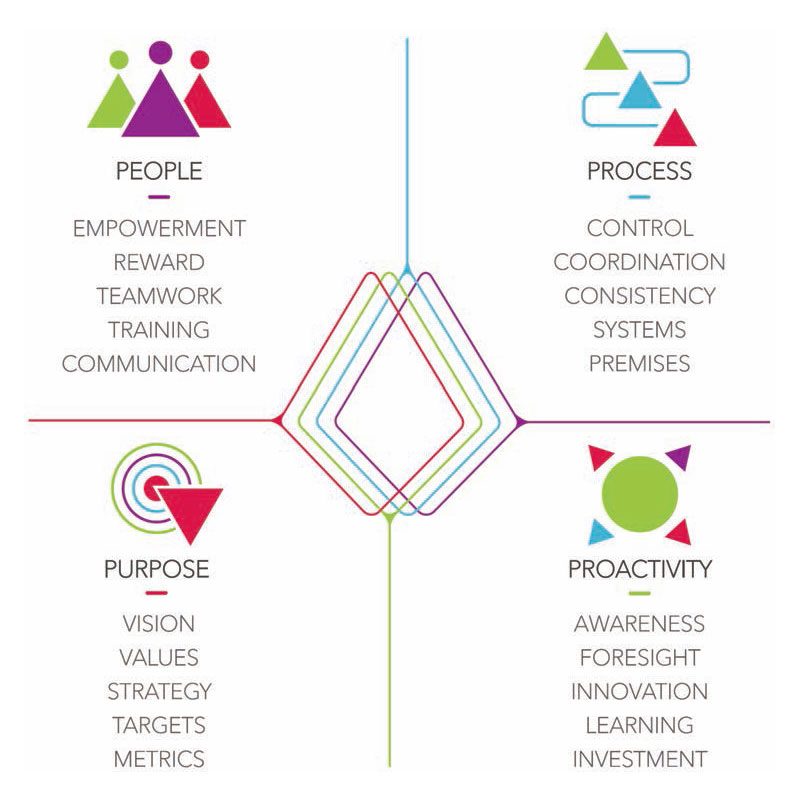
Training aspects of food safety culture
30 July 2019 | Bertrand Emond, Head of Membership and Training
Bertrand Emond, Head of Membership and Training at Campden BRI, explains how companies can achieve excellence in their training programmes to strengthen their food safety culture.
The GFSI Food Safety Culture Position Paper1 defines food safety culture as: shared values, beliefs and norms that affect mindset and behaviour toward food safety in, across and throughout an organisation. Food safety is a shared responsibility and all employees have a role to play. Employees, irrespective of their position within a company, need to understand how their actions can have an impact (positive or negative) on food safety. To ensure the right behaviours at all times, each employee needs to have been trained properly; they need to know exactly what is expected of them, what the right thing to do is, how to do things right and crucially what the consequences are to them directly and to the company of not doing the right thing!
Companies also need to bear in mind that training is one of 20 dimensions that companies need to address to drive a strong food safety culture - as described in the GFSI position paper and in the Culture Excellence model2 (see Figure 1). So, in the case of a near miss or incident, it is critical to carry out a thorough root cause analysis to determine the real reasons why the person behaved in that way; far too often, we see ‘re-training’ as the sole corrective action.

Figure 1. Culture Excellence model
As part of Campden BRI’s work supporting companies with their food safety culture excellence programmes, it is clear that many companies struggle with ‘training’ as HR staff are typically not as engaged as they should be and not providing enough support to the technical functions within the food safety training activities. The most common feedback received includes:
- Training is not effective and has no direct impact on behaviour
- Training is not frequent enough and refreshers are late
- Training is not perceived as enjoyable and worthwhile
- Training has no clear and measurable objectives
- Perception of what constitutes training varies
- There is no robust training needs analysis across the organisation
- The competency/capability framework is non-existent or sketchy.
This is quite worrying as corporations and individuals need to learn new knowledge and skills quickly and need to be able to apply them effectively; high quality training is essential to ensure that employees are competent.
In order to make the food safety training as effective as possible and to optimise the transfer of skills and knowledge, an organisation needs to get the following basic elements right:
What and to whom
What is covered during the training session has to be pitched at the right level for the intended participants; you need to be clear what level of proficiency you are hoping to achieve - ranging from basic awareness to an expert able to train others! The content has to be relevant and as specific as possible to the participants’ roles and responsibilities to ensure they are competent, qualified and confident to perform their jobs. They also need to be able to use the new knowledge or skill as soon as possible after the training session, otherwise they are highly likely to forget most of it very quickly.
When it comes to food safety, it is a shared responsibility and all parts of the organisation have a role to play. Senior leaders and support functions, such as procurement, logistics and finance, tend to be forgotten. They all need to have at least an awareness of the food safety risks and hazards affecting their business and be clear on their responsibilities to ensure food safety is not compromised by one of their actions.
A common area which needs improvement is the time and resources dedicated to onboarding/induction of new employees and training of agency/temporary staff. No employee should be allowed to carry out work without having completed the necessary training or induction and without having the confidence of knowing what is expected of them and what their accountability and responsibilities are. Unfortunately, far too many companies are under huge commercial pressure and choose to compromise on this.
A competency framework needs to be established to define the knowledge, skills, abilities and behaviours that members of staff at all levels need to perform their food safety roles effectively. To ensure that the roles are well understood and defined, it is good practice to get input from the job holder, supervisors and also HR. The benefits highlighted by businesses who have adopted these frameworks include:
- Employees are clearer on what is expected of them
- Clearer accountability across the organisation
- More effective recruitment and new staff selection
- More effective performance evaluation
- More efficient identification of skill and competency gaps
- More customised training and professional development
- More effective succession planning
- More efficient change management processes.
How
How the above content is delivered needs to be adapted to the intended recipients taking into account demographics, such as literacy level, language, cultural and generations variation, and learning preferences. Spaced short focused and engaging/interactive sessions seem to be more effective than a one-day cramming course. Some companies have developed great training materials purely based on pictures to address literacy and language related challenges. Training should include a range of learning opportunities, such as education, experience/on the job, coach ing and mentoring, networking, work shops and conferences, job shadowing etc. - not just the dreaded PowerPoint, classroom, once a year talk or 15 mins on a computer clicking through slides ‘sheep dip’ approach!
A blended approach combining face-to-face activities and online learning has been adopted by a growing number of businesses as well as interactive training systems, gamification and microlearning. There are some very exciting computer technology developments, which help to make training adaptive, personalised, interactive, engaging, fun and memorable, including augmented reality, virtual reality, alternate reality computer games, wearables and smart goggles that enable expert remote assistance (as and when needed) and also enable remote on the job training and competency assessment.
Well-designed assessments, (e.g. quizzes, surveys, tests, exams, projects/assignments), are great tools to support learning (by providing search and retrieval practice), minimise forgetting, confirm skills, knowledge and behaviours and motivate people by giving them a sense of achievement and confidence (through the results and feedback received). The type of assessments used will obviously depend on the target level of proficiency and expertise and needs to be relevant and proportionate.
There are many benefits of asking questions. Questioning constitutes a form of repetition, which helps learning (especially if spaced over time for example at weekly shift/team huddle), it forces learners to focus attention, to interact and think a problem through and provides the opportunity to get feedback to correct misconceptions and check understanding.
It is worth remembering that context is critical in learning; are the employees going to be able to retrieve the required information when they need it in the heat of the action? This is where ‘on the job’ assessments play a key role; these assessments can be by peers (buddy or team with everybody looking out and supporting each other) and/or supervisors/managers.
Companies that are driving a strong food safety culture as part of their staff development activities, actively measure and assess employee performance and behaviours, recognising that this allows for a two-way conversation between a supervisor/manager and an employee to address incorrect behaviours and to praise good behaviours.
When
The training session (online or face-to-face) needs to be held at a time when the recipients are in a good mental and physical state and ready to receive and assimilate. There is little point organising it at the end of an exhausting day/shift or just before a company shutdown or holiday period. It should also be done at a dedicated time and not during break time! Having said that, there are some very effective games that can be played during breaks that act as great refreshers.
Where
The location needs to be conducive to learning, free from distractions and comfortable in terms of light, temperature, facilities and space with refreshments available if needed.
Why
This is key and many businesses keep missing this one; it is essential that the individuals understand why they are getting this training, why it is important and what the success evaluation criteria will be. They should be prepared and there should be a sense of accountability for using the new knowledge and skills. It is equally essential that the work environment supports the use of knowledge and expertise so peers and supervisors/managers need to understand the role they have to play as part of this training, including support, feedback and coaching.
It is widely acknowledged that people’s food safety behaviour is significantly influenced by their supervisor/manager’s commitment and attitude towards food safety. In order for new knowledge and skills to be successfully applied, the supervisor/manager needs to be fully aligned, committed, consistent and supportive. There should be a clear management commitment to providing an adequate level of resources including time, facilities and budget to ensure that food safety training and education is not compromised.
We have found that the most mature organisations use approaches based on competency-based learning. Competen cy-based learning systems focus on front-end analyses to determine the desired knowledge, skills, abilities and behaviours necessary for high-level job performance. Such systems emphasise the use of as sessments to determine the level of com petence against desired outcomes and focus learning and developmental efforts on helping the individual determine a learning path and the learn ing experiences necessary to attain the desired competencies. The instructional design methodology known as ADDIE (analysis, design, develop ment, implementation and evaluation), coupled with stakeholder input, learning experience review and support systems, seems to make the system robust, efficient and effective.
Frank Yiannas in his book Food Safety = Behaviour (30 Proven Techniques to Enhance Employee Compliance)3 offers some great tips to ensure that food safety training is as effective as possible. Here are my top 10:
- Story rather than facts and statistics
- Commit in writing at the end of session
- What employees wear matters
- Important to show desired behaviour as the social norm
- Teach what ‘right’ looks like but also consequences of doing it wrong
- Give specific personal objectives for accountability
- Select who delivers message carefully
- Keep messages short and rhyming to make them memorable
- Picture rather than text
- Make it fun.
To reinforce the right behaviour and keep the critical elements of food safety at the top of the mind, the training or learning activity needs to be complemented by regular messaging and communication, including, for example, regular campaigns focused on specific food safety topics (e.g. hand washing week, cross-contamination day), signs and posters located in relevant areas, reward/incentive/awards/recognition programmes, supervisor/shift huddles, videos, reminder of consequences of not doing the right thing, social network and messenger (e.g. WhatsApp, Yammer).
Effective training is a key component of a strong food safety culture and there are many benefits reported by companies with successful programmes of staff training and continuing professional development (CPD) including:
- Increased job satisfaction and morale among employees
- Increased employee motivation
- Increased efficiencies in processes, resulting in bottom line benefits
- Increased capacity to adopt new technologies and processes
- Increased levels of innovation in strategies, products and processes
- Reduced employee turnover (due to the perception of being valued)
- Enhanced company image (resulting in the successful recruitment of higher calibre staff)
- Reducing Risk (through training staff on a range of subjects from Food Safety and Hygiene to Traceability and Cultural Diversity).
Conclusions
There should be a clear management commitment to ensure that enough time and budget is devoted to training to do it properly. We need to do what we do better and smarter to optimise the return on invest ment and effort. We also need to keep in mind the following quotes:
The only thing worse than training good employees and losing them, is not training your employees and keeping them" - Zig Ziglar
If you think training is expensive, try ignorance and stagnation" - Peter Drucker

About Bertrand Emond
Bertrand has a wealth of knowledge, experience and connectivity from working here at Campden BRI since 1988. Bertrand has a Master's in Food Science & Technology (Dijon, France) and a Master's of Business Administration (Bath, UK).
Bertrand is passionate about supporting the industry in the areas of skills, knowledge, training, learning and development, competency and achieving culture excellence through behaviour change. He won the 2020 BRCGS CEO Europe Award recognising his commitment and contribution to food safety and the 2014 Heinz Award for Excellence for Leadership in Collaborative CPD for the Industry (in particular for his role in supporting competency and CPD, promoting the food industry as a career of choice, and providing collaboration between all stakeholders).
Culture excellence seminar white paper
Click below to download a copy of the white paper in PDF format
How can we help you?
If you’d like to find out more about food safety culture, contact our support team to find out how we can help.
References
- 1 A Culture of Food Safety - a Position Paper from the Global Food Safety Initiative (GFSI) April 2018 https://www.mygfsi.com/images/A_Culture_Of_Food_Safety/GFSI-Food-Safety-Culture- FULL-VERSION.pdf
- 2 Culture Excellence programme: www.culturexcellence.com and www.campdenbri.co.uk/culture-excellence.php
- 3 Frank Yiannas. Food Safety = Behavior - 30 proven techniques to enhance employee compliance. Springer, 2015.







